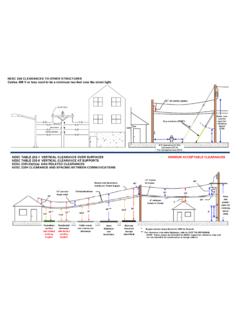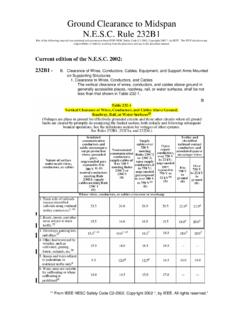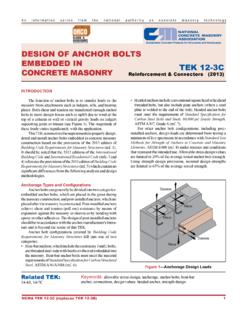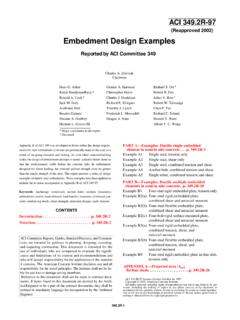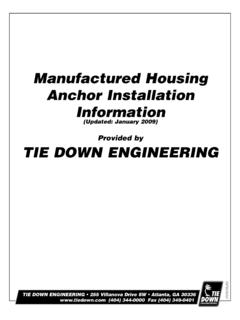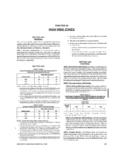Transcription of OREGON JOINT USE ASSOCIATION STANDARDS …
1 OREGON JOINT USE ASSOCIATION . STANDARDS COMMITTEE. BEST PRACTICES GUIDE. APRIL 2009. ACKNOWLEDGMENTS. Construction STANDARDS Subcommittee Membership Dave Cheney, Accent Communications Stan Cowles, Qwest Jim Flu, PacifiCorp Keshvar Jafari, PGE. Scott Jennings, Verizon Tamara Johnson, Springfield Utility Board Rob Kolosvary, PGE. Gary Lee, Charter Communications Jeff Liberty, Bend Broadband Jim McGuire, PGE. Michelle Ness, Central Lincoln PUD. Gary Payne, Qwest Gary Putnam, PUC. Troy Rabe, Comcast Stuart Sloan, Consumers Power John Wallace, PUC. Jim Watkins, PacifiCorp Scott Wheeler, Comcast Bill Woods, PacifiCorp TABLE OF CONTENTS. Chapter 1 - Anchors .. 1. A. Placement Considerations: .. 1. B. Common Types of Anchors and Installation.
2 4. Testing the Anchor: .. 8. Chapter 2 - Bonding and Grounding .. 9. A. Definition of Bonding .. 9. B. Bonding Installation Considerations .. 10. C. Types of Bonds Installations: .. 10. D. Types of Bonding Connectors: .. 11. E. Definition of 11. F. Grounding Installation Considerations .. 11. G. Types of Grounds .. 12. H. Street Light 13. I. Bonding Risers .. 14. Chapter 3 - Framing .. 15. A. Definition of Framing .. 15. B. Site Specific Construction .. 15. C. Types of Framing .. 16. D. Avian Protection Construction .. 20. E. Construction 20. F. Ground Clearances .. 20. G. Voltage 21. Chapter 4 - Poles .. 22. A. Definition of a Pole .. 22. B. Placement .. 22. C. Types .. 22. D. Identification .. 23. E. Grades of Construction.
3 24. F. Pole Class:.. 24. G. Pole top Extensions .. 25. H: Pole Supports: .. 26. Chapter 5 - Risers .. 29. A. Definition of Riser .. 29. B. Placement Considerations: .. 29. Chapter 6 - Tension and Sag .. 34. A1. Definition of Tension .. 34. A2. Definition of Sag .. 34. B. Engineering Design .. 35. C. Methods of Tensioning: .. 35. D. SLACK SPAN (Reduced Tension Construction) .. 36. E. Guy Tension .. 36. F. Line of 37. G. Sag Charts .. 37. H. Loading Zone: .. 38. I. Grades of Construction .. 39. J. Resources:.. 40. Chapter 7 - Support Arms .. 41. A. Definition of Support Arm .. 41. B. Placement considerations .. 41. C. Types: .. 42. D. Braces: .. 48. E. Lengths of Arms:.. 48. F. Pole Gains .. 49. G. Installation: .. 49. Chapter 8 - Equipment Pictorial.
4 50. A. Definition of Equipment .. 50. B. General Equipment .. 50. C. Supply Equipment .. 52. D. Telco Equipment: .. 54. E. Cable Equipment:.. 55. F. Fiber 55. G. Wireless Equipment .. 56. CHAPTER 1 - ANCHORS. This document is intended to provide education on common Construction Practices for aerial construction of power and telecommunications facilities. This is not an official codebook, nor should it be construed as a construction manual. When constructing aerial facilities, please refer to the governing codes, such as the ational Electrical Safety Code, ational Electric Code, OREGON Public Utility Commission Safety Rules, OREGON Occupational Safety And Health Administration, State, County and Municipal codes, and all other applicable STANDARDS , including contracts.
5 The 2007 National Electrical Safety Code (NESC) addresses anchors in Sections 253, 261, and 264. Table of Contents: A. Placement Considerations B. Common Types of Anchors & Installation A. PLACEMENT CONSIDERATIONS: The distance between the anchor and the pole is generally based on the load the anchor is required to hold, and the anchor type. There are other considerations that are dealt with in this chapter as well. Anchors are generally placed five (5) feet from an existing anchor. This is done to ensure the soil surrounding the existing anchor is not loosened while installing the new anchor. Heights to lead ratio means that for every one foot of pole height that place your attachment, you place the anchor one foot away from the pole.
6 1:1 ratio is optimum 2:1 ratio is good 3:1 ratio is the minimum When identifying the need to have your plant guyed at a specific location, you may observe another utilities' anchor. This anchor may have an available open eye. You must first get permission from the anchor owner prior to occupying that open eye with your guy. 1. These are eye bolts that are attached to an anchor rod above grade. When all available eyes on the rod are occupied, some utilities may allow the use of auxiliary eye attachments. This hardware is clamped to the existing rod above grade, and enables another guy to be attached to the anchor. Newly installed anchor rods should have no more than 12 of exposed rod above grade. Anchor rods should be placed in lead with the facilities they are supporting.
7 The rod should be aimed towards the spot on the pole where the guy is attached (with the exception of sidewalk guys). Soil Types: Soil testing is necessary to determine the proper anchor type. A soil probe is performed with a mechanical soil test probe tool that is screwed into the soil. As it displaces the soil, probe installation torque is measured in inch-pounds on a torque gauge, which is an integral part of the installing tool. Probe torque readings are then compared with the information on the Soil Classification Data Chart and translated into the appropriate soil classification. 2. Easement Considerations: An easement is the right of use over the real property of another. It is distinguished from a license or permit that only gives one a personal privilege to do something on the land of another usually the permission to pass over the property without creating a trespass.
8 Easements may be considered public or private. A private easement is limited to a specific individual such as the owner of an adjoining land. A public easement is one that grants the right to a large group of individuals or to the public in general, such as the easement on public streets and highways. You must consider land use easements when placing an anchor! Permit Considerations: There are many different permits that may be required that are related to construction activity of this type, including OREGON Department of Transportation, City, Municipal, and others. Please consult the necessary agencies to ensure you are in compliance with the governing agencies. Locates: The OREGON Utility Notification Center (OUNC) is the one-call agency dedicated to safeguarding citizens and construction personnel who work around utilities, as well as safeguarding the underground infrastructure of pipes, mains and lines which bring utilities to your community.
9 Calling at least two working days before beginning any excavation prevents damage to underground facilities, service interruptions, and bodily injury. The number is 1-800-332-2344. 3. B. COMMON TYPES OF ANCHORS AND INSTALLATION. Plate Helix / Screw Expanding / Bust Manta Ray Swamp Rock Plate anchor: The Cross-Plate anchor is made for installation in holes drilled by power diggers. Because the size of the hole does not affect holding capacity, the same auger that is used to dig the pole holes on transmission projects can dig the hole. Cross-Plate anchors are installed in a diagonal bored hole, which is undercut so the anchor is at right angles to the guy. A rod trench is either cut with a trenching tool or drilled with a small power auger.
10 Both anchor and rod trench should be refilled and tamped. 4. Helix / Screw anchor: Screw-in anchors are recommended for softer soil types, Classes 5-7 in Table 1. They do not work well in rocky soils. Screw-in anchors are usually installed by two people rotating a log bar threaded through the eye, but may also be installed with a power drive machine. Screw-in anchors can also be used in applications where an anchor will be embedded in concrete. Expanding / Bust anchor: Bust Expanding Anchors expand to take full advantage of the available area. All eight blades wedge into undisturbed earth. There is no wasted space between blades. This anchor should be installed in relatively dry and solid soils. The effectiveness of the anchor is dependent upon the thoroughness of backfill tamping.
